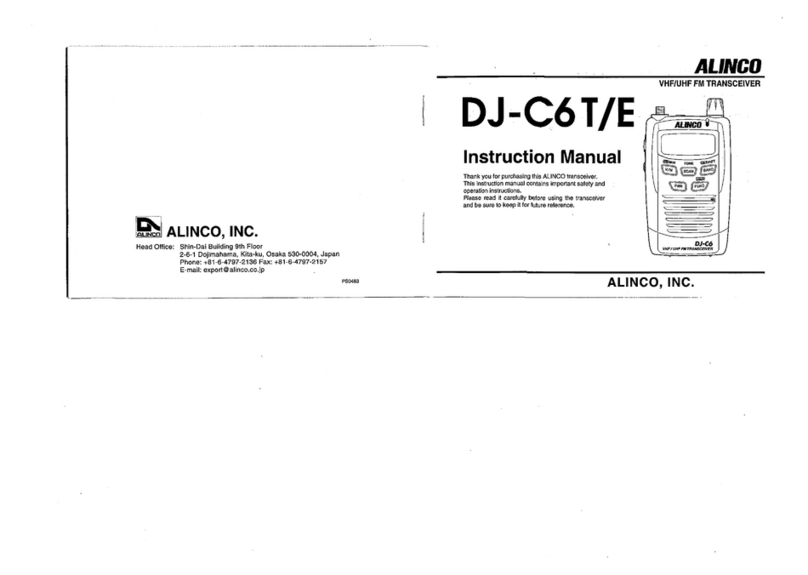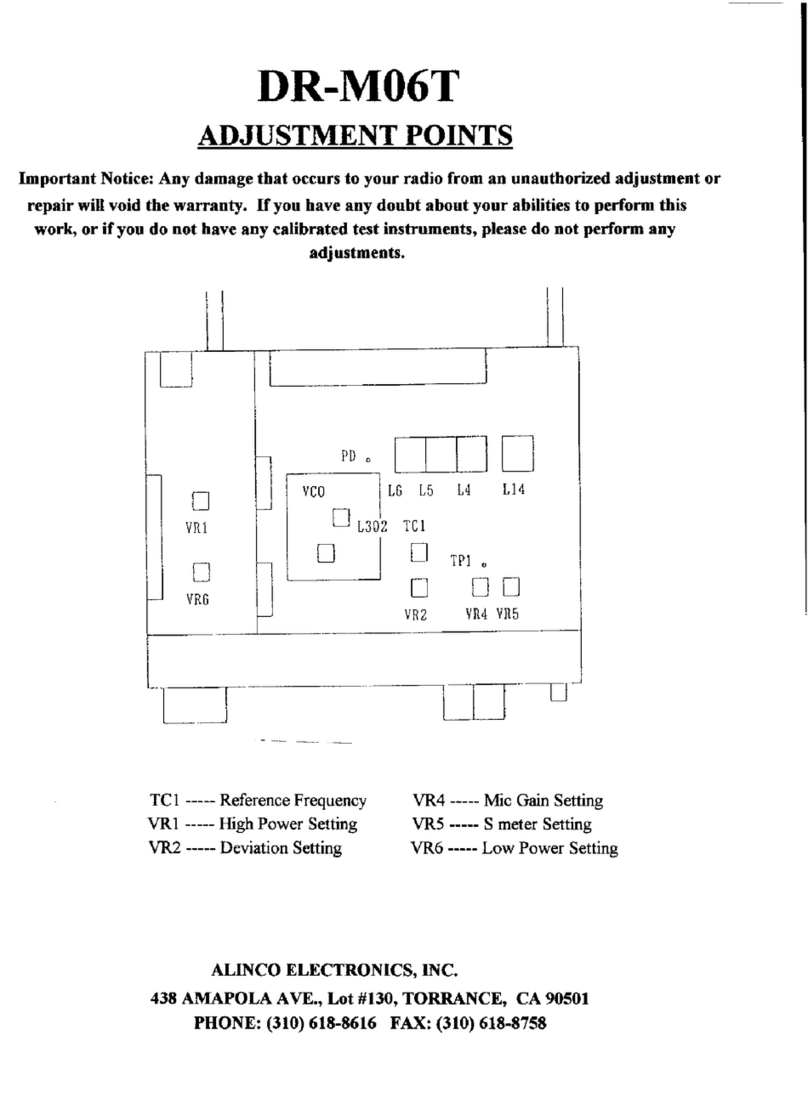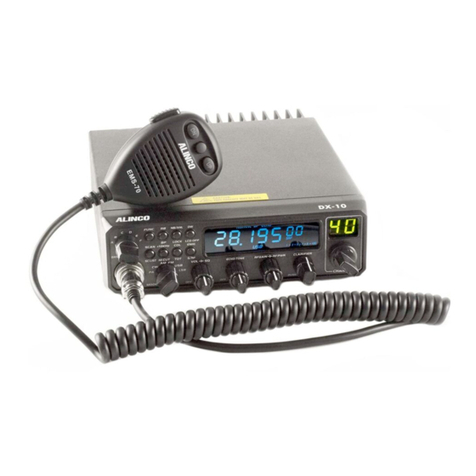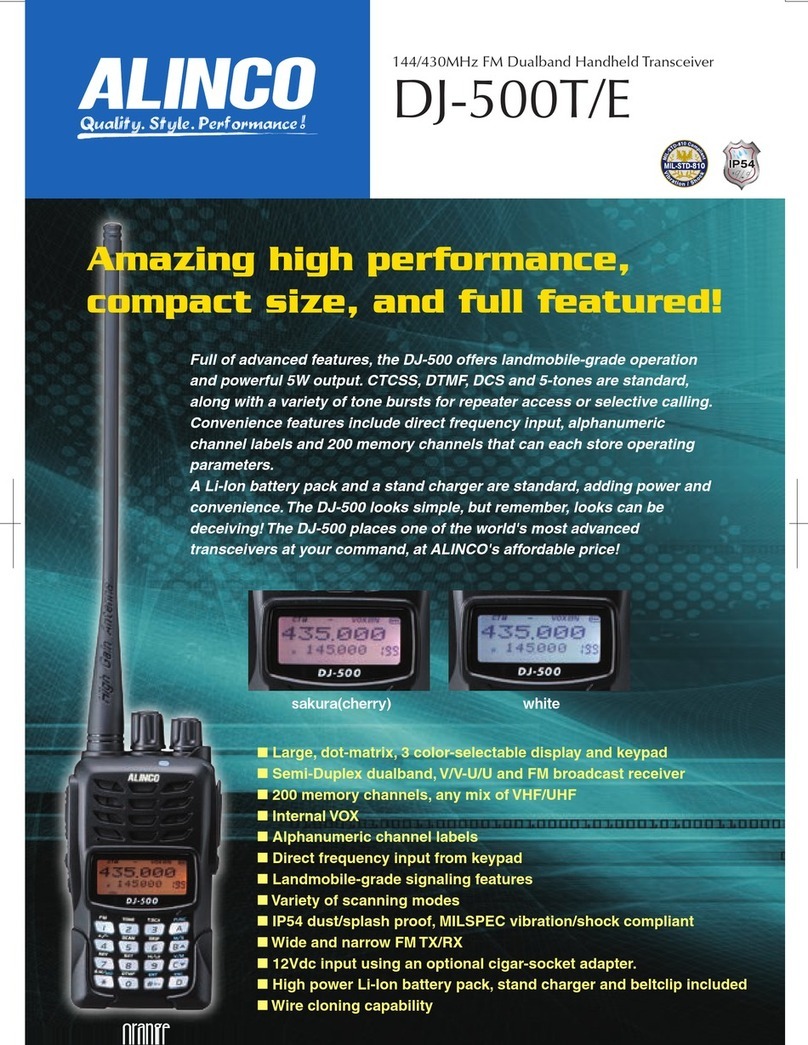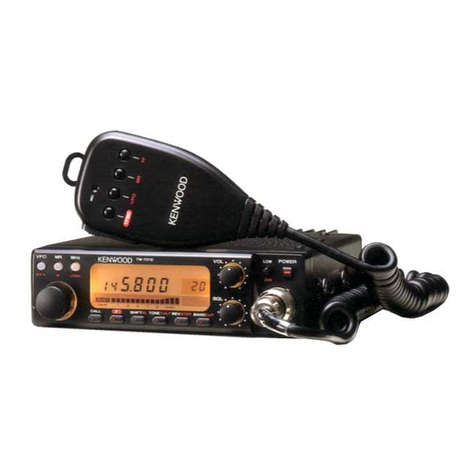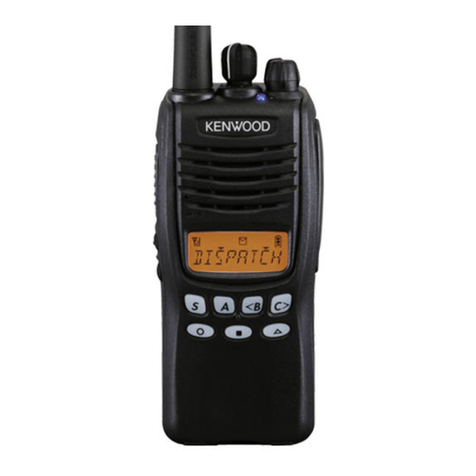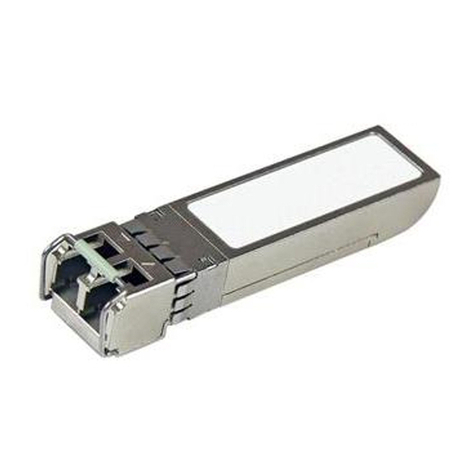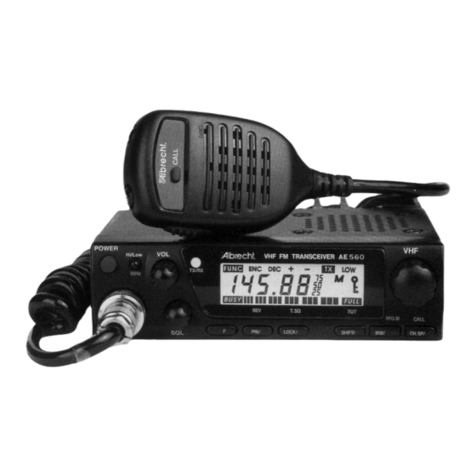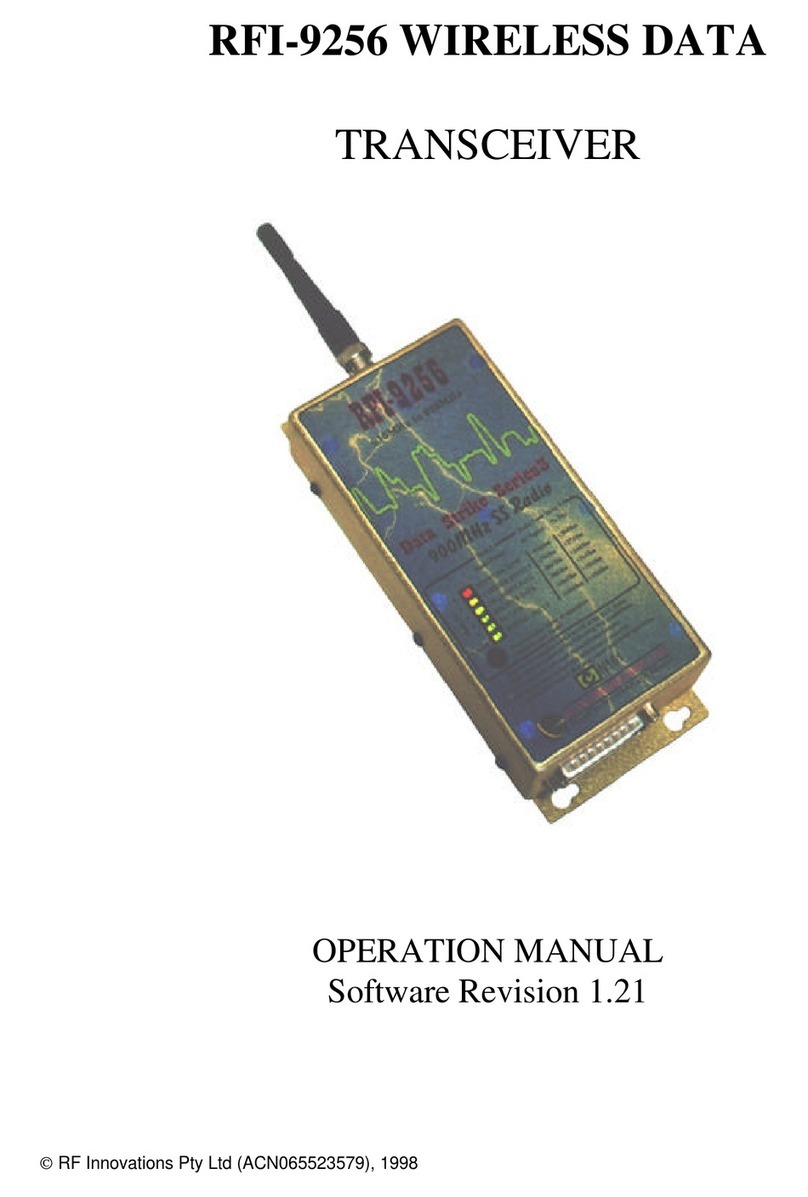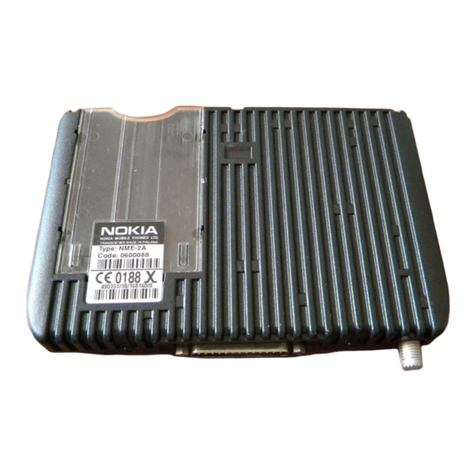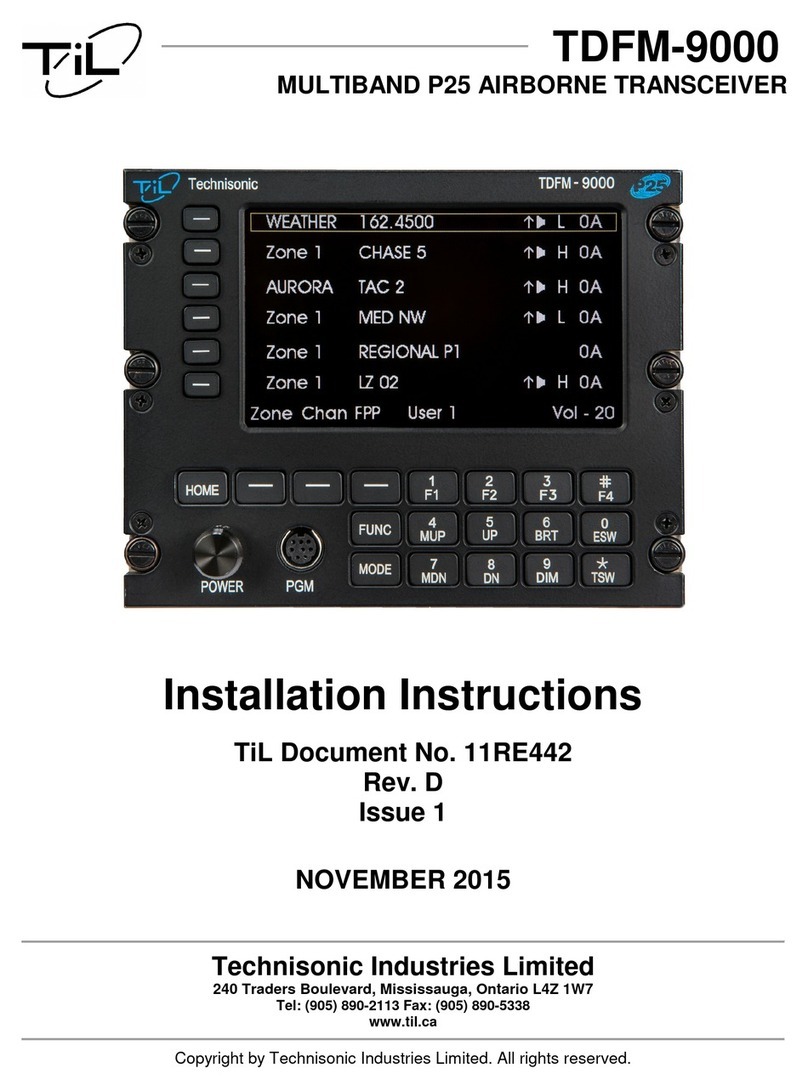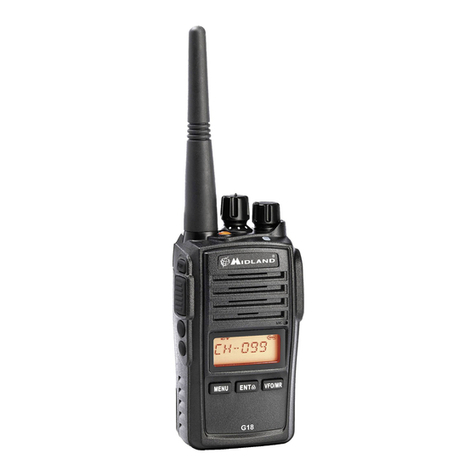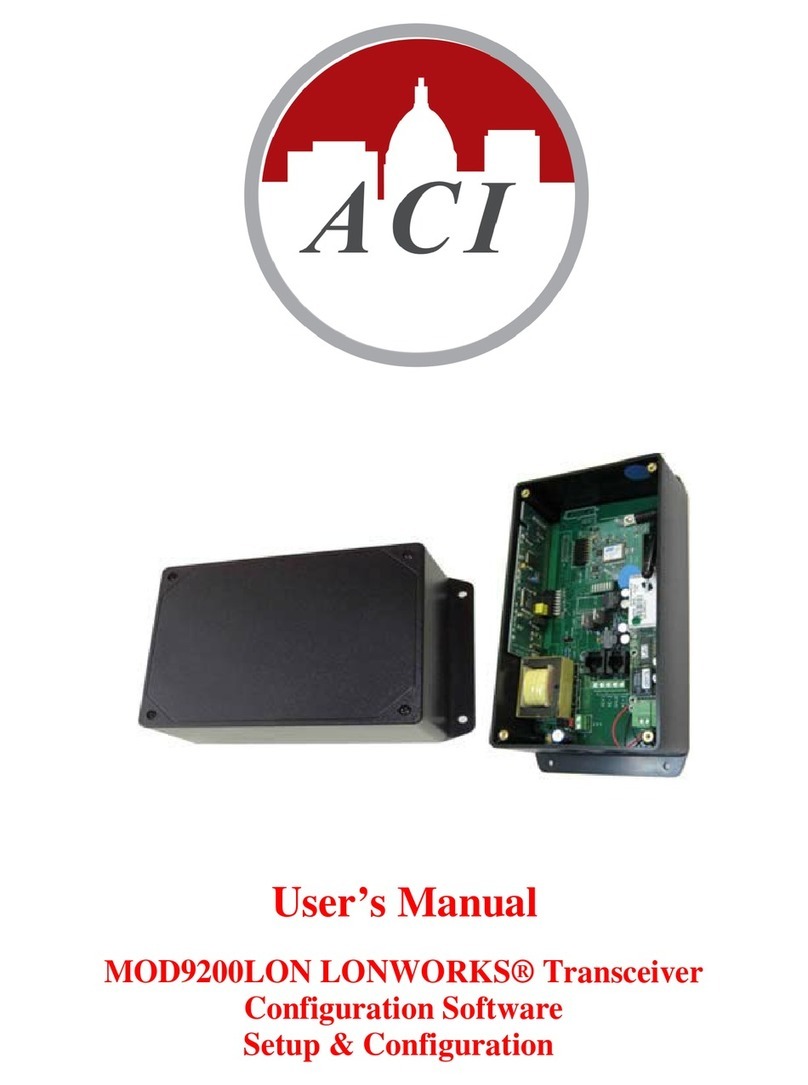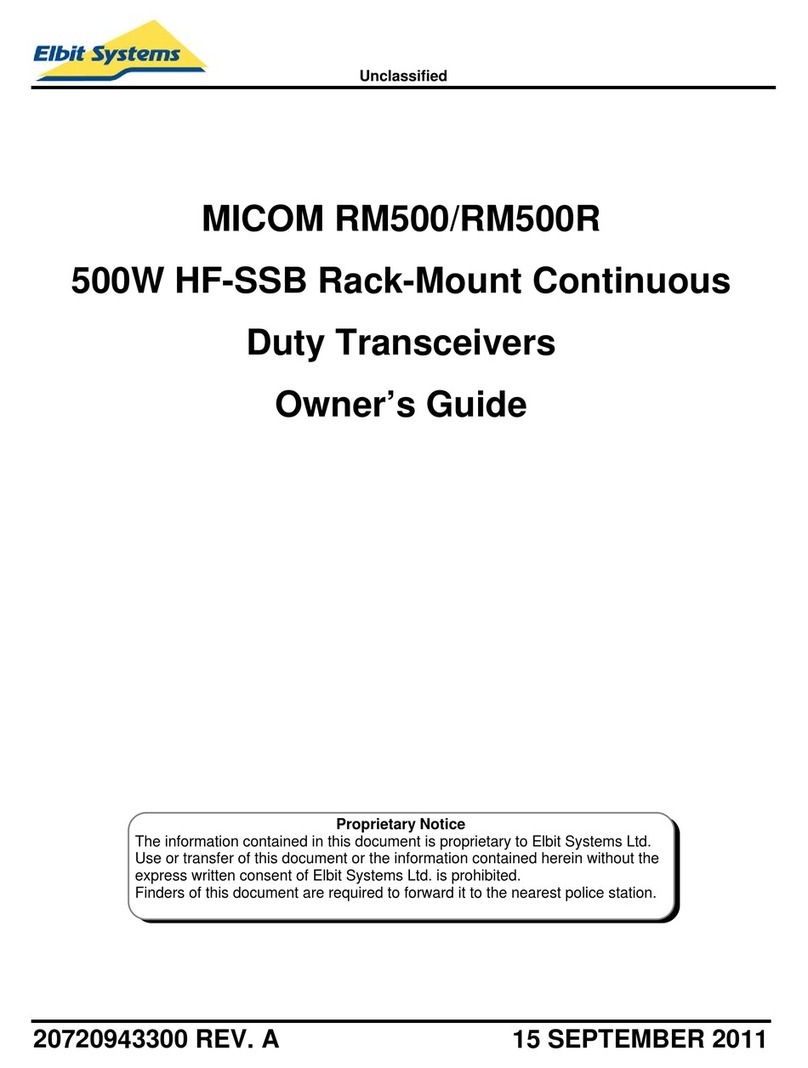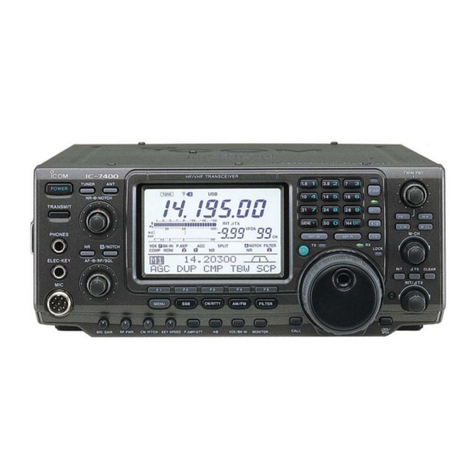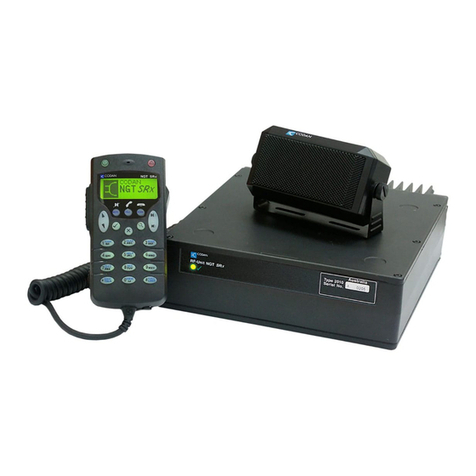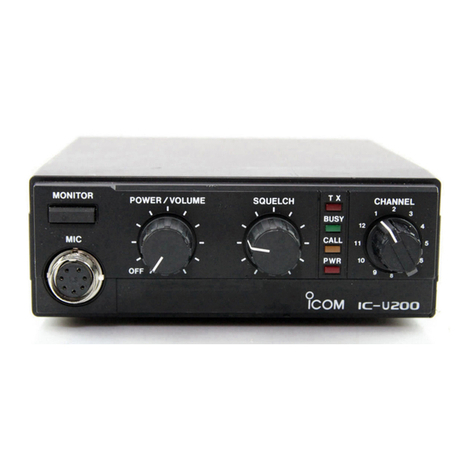Alinco DR-638H User manual

A1.140422
ALINCO, INC.
Yodoyabashi Dai-bldg 13F
4-4-9 Koraibashi, Chuo-ku, Osaka 541-0043 Japan
Phone: +81-6-7636-2362 Fax: +81-6-6208-3802
http://www.alinco.com
E-mail:[email protected]
Copyright Alinco, lnc. PS0820/FNEH-NI
Printed in China
DR-638HE: VHF/UHF FM amateur transceiver
144.000-145.995MHz/430.000-439.995MHz
Use of this device is authorized in all EU and EFTA member
states(CH/ICE/LI/NOR).
Operator's license is required.

DR-638H
Instruction Manual
VHF/UHF FM Mobile Transceiver
Thank you for purchasing your new Alinco transceiver.
Please read this manual carefully before using the
product to ensure full performance, and keep this
manual for future reference as it contains information
on after-sales services. In case addendum or errata
sheets are included with this product, please read
those materials and keep them together with this
instruction manual for future reference.

Introduction
Thank you very much for purchasing this excellent Alinco transceiver.
Our products are ranked among the finest in the world. This radio has
been manufactured with state of the art technology and it has been tested
carefully at our factory. It is designed to operate to your satisfaction for
many years under normal use.
Please read this manual completely from the first page to the
last, to learn all the functions the product offers. It is important to
note that some of the operations may be explained in relation to
information in previous chapters. By reading just one part of the
manual, you may risk not understanding the complete explanation
of the function.
Before transmitting
There are many radio stations operating in proximity to the frequency
ranges this product covers. Be careful not to cause interference when
transmitting around such radio stations.
■ Lightning
Please note that no car provides adequate protection of its passengers
or drivers against lightning. Therefore, Alinco will not take responsibility
for any danger associated with using its radios or inside the car during
lightning.
Conformity Symbols
Tested to comply MIL-STD-810G
-Shock: Method 514.6/I,IV -Vibration: Method 516.6/I
CE Conformity Information
This device is in compliance with the essential requirements of R&TTE
Directive 1999/5/EC.
A copy of the certicate by the notied body can be reviewed at http://
www.alinco.com/usa.html.
DR-638HE
VHF/UHF FM Amateur Transceiver
144.000-145.995MHz/430.000-439.995MHz
This device is authorized for use in all EU and EFTA member states.
An operator's license is required for this device.
Check with your local waste ofcials for details on recycling or
proper disposal in your area.
Manufacturer:
ALINCO, Inc. Electronics Division
Yodoyabashi Dai-bldg. 13F
4-4-9 Koraibashi, Chuo-ku,
Osaka 541-0043 Japan

To prevent any hazard during operation of Alinco’s radio product, in this
manual and on the product you may nd symbols shown below. Please
read and understand the meanings of these symbols before starting to
use the product.
Danger
This symbol is intended to alert the user to an
immediate danger that may cause loss of life and
property if the user disregards the warning.
Alert
This symbol is intended to alert the user to a possible
hazard that may cause loss of life and property if the
user disregards the warning.
Caution
This symbol is intended to alert the user a possible
hazard that may cause loss of property or injure the
user if the warning is disregarded.
Alert symbol. An explanation is given.
Warning symbol. An explanation is given.
Instruction symbol. An explanation is given.
ALERT
Environment and condition of use:
Do not drive while handling the radio for your safety. It is
recommended that you check local trafc regulations regarding
the use of radio equipment while driving.
Some countries prohibit the operation of transceiver while
driving.
Do not use this product in close proximity to other electronics
devices, especially medical ones. It may cause interference
to those devices.
Keep the radio out of the reach of children.
In case a liquid leaks from the product, do not touch it. It may
damage your skin.
Rinse with plenty of cold water if the liquid contacted your
skin.
Never operate this product in facilities where radio products
are prohibited for use such as aboard aircraft, in airports, in
ports, within or near the operating area of business wireless
stations or their relay stations.
Use of this product may be prohibited or illegal outside of
your country. Be informed in advance when you travel.
The manufacturer declines any responsibilities against
loss of life and/or property due to a failure of this product
when used to perform important tasks like life-guarding,
surveillance, and rescue.
Do not use multiple radios in very close proximity. It may
cause interference and/or damage to the product(s).
The manufacturer declines any responsibilities against loss
of life and property due to a failure of this product when used
with or as a part of a device made by third parties.
Use of third party accessory may result in damage to this
product. It will void our warranty for repair.
WARNING

Handling this product:
Be sure to reduce the audio output level to minimum before
using an earphone or a headset. Excessive audio may damage
hearing.
Do not open the unit without permission or instruction from the
manufacturer.
Unauthorized modication or repair may result in electric shock,
re and/or malfunction.
Do not operate this product in a wet place such as shower
room. It may result in electric shock, re and/or malfunction.
Do not place conductive materials, such as water or metal in
close proximity to the product. A short-circuit to the product
may result in electric shock, re and/or malfunction.
Do not touch the heatsink (on/around the unit mostly found on
mobile-base units) as it may become very hot during/after the
operation that may risk burn your skin.
About power-supply:
Use only appropriate, reliable and certified power supply of
correct voltage and capacity.
Do not connect cables in reverse polarity. It may result in
electric shock, re and/or malfunction.
Do not plug multiple devices including the power-supply into a
single wall outlet. It may result in overheating and/or re.
Do not handle a power-supply with a wet hand. It may result in
electric shock.
Securely plug the power-supply to the wall outlet. Insecure
installation may result in short-circuit, electronic shock and/or re.
Do not plug the power-supply into the wall outlet if the
contacts are dirty and/or dusty.
Shortcircuiting and/or overheating may result in re, electric
shock and/or damage to the product.
Do not modify or remove fuse-assembly from the DC-cable.
It may result in fire, electric shock and/or damage to the
product.
In case of emergency:
In case of the following situation(s), please turn off the product, switch
off the source of power, then remove or unplug the power-cord. Please
contact your local dealer of this product for service and assistance.
Do not use the product until the trouble is resolved. Do not try to
troubleshoot the problem by yourself.
• When a strange sound, smoke and or strange odor comes out of the
product.
• When the product is dropped or the case is broken or cracked.
• When a liquid penetrated inside.
• When a power-cord ( including DC-cables, AC-cables and adapters)
is damaged.
For your safety, turn off then remove all related AC-lines to
the product and its accessories including the antenna if a
thunderstorm is likely.
Turn off the unit, remove the mobile antenna from its base
and keep it in the vehicle if a thunderstorm is likely.
Please read cautions regarding the lightning-protection on
page 9 also.
Maintenance
Do not open the unit and its accessories. Please consult with
your local dealer of this product for service and assistance.
WARNING

CAUTION
Environment and condition of use:
Do not use the product in proximity to a TV or a radio. It may
cause interference or receive interference.
Do not install in a humid, dusty or insufficiently ventilated
place. It may result in electric shock, re and/or malfunction.
Do not install in an unstable or vibrating position. It may result
in electric shock, re and/or malfunction when/if the product
falls to the ground.
Do not install the product in proximity to a source of heat and
humidity such as a heater or a stove. Avoid placing the unit in
direct sunlight.
Do not modify, dismantle, incinerate, or immerse the batteries
that may be used in accessories you use with this product.
Please check your local regulations for details on recycling
option or disposal of the batteries in your area.
About transceiver
Do not connect devices other than specied ones to the jacks
and ports on the product.
It may result in damage to the devices.
Turn off and remove the power-source (AC cable, DC cable,
battery, cigar-cable, charger adapter etc) from the product
when the product is not in use for extended period of time or in
case of maintenance.
Use a clean, dry cloth to wipe off dirt and condensation from
the surface of the product.
Never use thinner or benzene for cleaning.
About power-supply
Use only reliable power supply of specic DC output range and
be mindful of the polarity of the cables and DC jack.
Always turn off the power supply when connecting or
disconnecting the cables.
When using an external antenna, make sure that the antenna
ground is not common with the ground of the power supply.
European users: When a transceiver is powered from an
external DC power source (adapter, power supply, cigar-plug
etc), make sure that this power supply has approval to the
level of IEC/EN 60950-1.
WARNING

CONTENTS
New and Innovative Features..............................................1
Supplied Accessories/Optional Accessories.....................2
Supplied Accessories.......................................................................2
Initial Installation ..................................................................3
Mobile installation ............................................................................3
DC Power Cable Connection ...........................................................4
Power supply voltage Display ..........................................................6
Antenna Connection ........................................................................6
Accessories Connections.................................................................6
Front Panel Separation ....................................................................7
Getting Acquainted ..............................................................8
Front panel.......................................................................................8
Rear panel .......................................................................................9
Display .............................................................................................9
Microphone .....................................................................................10
Basic Operations .................................................................11
Switching the Power On/Off............................................................. 11
Adjusting the Volume .......................................................................11
Squelch level setting ........................................................................11
Switch between VFO and memory mode ........................................11
Setting frequency ............................................................................. 11
Setting channel ................................................................................11
Switch Between Main Band and Sub band...................................... 12
Selecting the operating band ...........................................................12
Receiving .........................................................................................12
Squelch Off/Squelch Off Momentary................................................12
Transmitting .....................................................................................12
Transmit DTMF/2TONE/5TONE signaling ....................................... 13
High/Mid/Low Power Setting............................................................ 13
Frequency Reverse..........................................................................13
CTCSS/DCS setting.........................................................................13
Call channel recalling....................................................................... 13
CTCSS/DCS Scan ........................................................................... 13
Dual Watch.......................................................................................14
Emergency Alarm.............................................................................14
Channel/Frequency Scan ................................................................14
Channel Scan Skip ..........................................................................14
Memory Channel Programming .......................................................14
Search Scan Range Setting.............................................................14
Channel Copy ..................................................................................15
Channel Delete ................................................................................15
Memory Banks operation .................................................................15
PARAMETER SETTING MODE(SET MODE) .......................16
Menu 01: APO (Automatic power off) ..............................................16
Menu 02: Automatic offset ...............................................................16
Menu 03: VFO Channel Step Setting...............................................16
Menu 04: VFO Band lockout............................................................ 16
Menu 05: Beep Sound .....................................................................17
Menu 06: CPU Clock Frequency Setting .........................................17
Menu 07: 2Tone Encode Select.......................................................17
Menu 08: 5Tone Encode Select.......................................................17
Menu 09: Add Optional Signaling.....................................................18
Menu 10: Tone Encode Setup.......................................................... 18
Menu 11: Tone Decode Setup ......................................................... 18
Menu 12: Sub Band Display ............................................................19
Menu 13: DTMF Encode Pre-Loading Timing..................................19
Menu 14: DTMF Encode Transmitting Time ....................................19

CONTENTS
Menu 15: DTMF Encode Setup .......................................................19
Menu 16: Squelch Mode Setup........................................................20
Menu 17: Compander ......................................................................20
Menu 19: Tone Burst Tones .............................................................20
Menu 20: Hyper ...............................................................................20
Menu 21: Keypad Lockout ...............................................................21
Menu 22: PTT Lockout.....................................................................21
Menu 23: TOT Penalty .....................................................................21
Menu 24: Frequency Reverse..........................................................21
Menu 25: SUB Band Mute ...............................................................21
Menu 26: Editing Memory Name .....................................................22
Menu 27: Time-Out Timer(TOT).......................................................22
Menu 28-31: Microphone PA,PB, PC,PD key setup .......................22
Menu 32: RF Squelch ......................................................................22
Menu 33: Offset Direction ................................................................23
Menu 34: Scan Resume Condition ..................................................23
Menu 35: Priority Channel Scan ......................................................23
Menu 36: Offset Frequency .............................................................23
Menu 37: Display Mode ...................................................................24
Menu 38: Busy Channel Lockout(BCLO)......................................... 24
Menu 39: DTMF Self ID Enquiry ......................................................24
Menu 40: 5-TONE Self ID Enquiry................................................... 24
Menu 41: VFO Frequency Linkage ..................................................25
Menu 42: Wide/Narrow FM Mode ....................................................25
Menu 44-46: LCD backlight .............................................................25
Menu 47: Keypad backlight brightness ............................................25
Menu 48: Calling Record .................................................................25
Menu 49: AM Function .....................................................................26
Menu 51: VHF External speaker port ..............................................26
Menu 52: Beep Volume control .......................................................26
Menu 53: Talk Around .....................................................................26
Menu 54: Microphone Speaker........................................................ 26
Menu 55: Memory Banks Enquiry.................................................... 27
Menu 56: Memory Banks Linking.....................................................27
Menu 64: Password Function ..........................................................27
Microphone Operation .........................................................28
Send DTMF signaling ......................................................................28
Main/Sub band switching .................................................................28
Function operation through PA-PD keys..........................................28
Cable Clone...........................................................................30
Resume Factory Default ..................................................................30
Programming Software Installing and Starting .................31
Utility Software in Windows system .................................................31
Maintenance..........................................................................32
Trouble Shooting..............................................................................32
Specications .......................................................................33
Appendix ...............................................................................34
51 groups CTCSS Tone Frequency(Hz). ......................................... 34
1024 groups DCS Code................................................................... 34

1
1New and Innovative Features
758 memory channels.
50 Watts of power output on the VHF band and 40 Watts on the
UHF band.
UU, UV, VU, VV operations.
A large LCD with selectable backlit color, Keys and microphone
keypads are also backlit and ensures comfortable operation in the
dark.
CTCSS, DCS, 2-tones, 5-tones and tone-bursts for repeater access
and sellective calling operations.
Various scan functions including CTCSS/DCS Scan.
Variety of signaling such as emergency alarm, ANI/DTMF, remote-
kill/revive features.
Compander function to decrease the background noise and
enhance audio clarity.
Wide and Narrow-FM modes supported. (25KHz/20KHz/12.5KHz)
Theft alarm provides extra safety.

2
2
Supplied Accessories
Supplied Accessories
Carefully unpack to make sure the following items are found in the package in addition to this manual:
Transceiver
DR-638
Spare Fuses
Microphone EMS-77
(with DTMF keyboard)
Mobile Mounting
Bracket
DC Power Cable with
Fuse Holder
Hardware Kit for Bracket
Black screws
(M4X8mm)
4PCS
Tapping screws
(M5X8mm)
4PCS
S-Washer
User Manual Mic Hanger Unit
The standard accessories may vary slightly depending on the version you have purchased. Please contact your local authorized Alinco dealer should
you have any questions. Alinco and authorized dealers are not responsible for any typographical errors there may be in this manual. Standard
accessories may change without notice.
Warranty Policy: Please refer to any enclosed warranty information or contact your authorized Alinco dealer / distributor for the warranty policy.
■ In order to operate this product, a properly tuned antenna, its feedline with connectors and xing hardware are necessary. Please
consult with your dealer for details.

3
Install the mounting bracket in the vehicle using the supplied self-
1.
tapping screws (4pcs) and at washers (4pcs).
3
Car body
Washer (M5)
Tapping screw
(M5x20mm)
Mounting bracket
Initial Installation
Mobile installation
Determine the appropriate angle of the transceiver, using the 3 screw
hole positions on the side of the mounting bracket.
The transceiver may be installed in any position in your car, where the
controls and microphone are easily accessible and it does not interfere
with the safe operation of the vehicle. If your vehicle is equipped with
air bags, be certain your radio will not interfere with their deployment. If
you are uncertain about where to mount the unit, contact your vehicle's
dealer.
Caution:
Use only the provided screws
otherwise you risk damaging
the circuit board, components
or fall-off of the unit.
Position the transceiver, then insert and tighten the supplied
2. hexagon
SEMS screws.
Double check that all screws are tightened to prevent vehicle
vibration from loosening the bracket or transceiver.

4
3
Red
Black
Initial Installation
DC Power Cable Connection
Mobile Operation
The vehicle battery must have a nominal rating of 12V. Never
connect the transceiver to a 24V battery. Be sure to use a 12V
vehicle battery that has sufficient current capacity. If the current
to the transceiver is insufficient, the display may darken during
transmission, or transmitting output power may drop excessively.
When the ignition key is turned to ACC or ON(Start) position with
7.
the radio turned off, the power switch illuminates. The illumination
will be turned off when the ignition key is turned to the off position.
To turn on the unit, press the power switch manually while it is
illuminated. (While ignition key is at ACC or ON position)
When the ignition key is turned to ACC or ON position with the
8.
radio's power switch on, the unit turns on automatically and the
power switch will be lit. Turn the ignition key to OFF position or
manually turn the power switch off to shut down the radio.
Use of ignition-key ON/OFF feature drains 5mAh of current from
9.
the battery as long as the EDC-43 is being connected.
Route the DC power cable supplied with the transceiver directly
1.
to the vehicle's battery terminals using the shortest path from the
transceiver.
Never use the cigarette lighter socket as a DC source.
The entire length of the cable must be dressed so it is isolated from
heat, moisture, and the engine secondary (high voltage) ignition
system/cables.
After installing cable, in order to avoid the risk of damp, please
2.
use heat-resistant tap to tie together with fuse box. Don't forget to
reinforce whole cable.
In order to avoid the risk of short circuit, please cut down
3.
connection with negative (-) of battery, then connect with radio.
Confirm the correct polarity of the connections, then attach the
4.
power cable to the battery terminals; red connects to the positive (+)
terminal and black connects to the negative (-) terminal.
Never remove the fuse holders from the cable.
Reconnect any wiring removed from the negative terminal.
5.
Connect the DC power cable to the transceiver's power supply
6.
connector.
Press
the connectors rmly together until the locking tab clicks.
If the ignition-key on/off feature is desired(optional feature), use
the optional EDC-43(For Cigar-Plug connection) cable. Connect
one of the cables between the ACC terminal or a Cigar-Plug that
operates with the vehicle ignition or ACC switch on the vehicle and
EXT POWER jack on the rear side of the unit.
Ext. Power jack
DC power cable

5
3Initial Installation
Before connecting the DC power to the transceiver, be sure to
switch the transceiver and the DC power supply OFF.
Do not plug the DC power supply into an AC outlet until you make
all connections.
In order to use this transceiver for xed station operation, you will need
a separate 13.8V DC power supply (not included), Please contact local
dealer to require.
The current capacity of your power supply must be 12A or more.
Connect the DC power cable to the regulated DC power supply
1.
and ensure that the polarities are correct. (Red: positive, Black:
negative).
Never directly connect the transceiver to an AC outlet.
Use the supplied DC power cable to connect the transceiver to a
regulated power supply.
Do not substitute a cable with smaller gauge wires.
Connect the transceiver's DC power connector to the connector
2. on
the DC power cable.
Press the connectors rmly together until the locking tab clicks
.
Red
Black
DC power cable with fuse holder
Regulated
power supply
Fixed Station Operation
Ext. Power jack
ACC terminal
Cigar-Plug connection
Optional EDC-43 required
REPLACING FUSES
If the fuse blows, determine the cause, then correct the problem. After
the problem is resolved, replace the fuse. If newly installed fuses
continue to blow, disconnect the power cable and contact your dealer
for assistance.
Only use fuses of the specified type and rating, otherwise the
transceiver could be damaged.
Fuse Location Fuse Current Rating
Transceiver 15A
Supplied Accessory DC
power cable 20A
If you use the transceiver for a long period when the vehicle battery is
not fully charged, or when the engine is OFF, the battery may become
discharged, and will not have sufcient reserves to start the vehicle. Avoid
using the transceiver in these conditions.

6
3
Initial Installation
External Speaker
If you plan to use the optional external speaker/s, There are 2
options. For a single speaker, plug into the 3.5mm SP Jack on the
rear of the radio to hear both bands through one speaker. To use dual
speakers, use the stereo plug it into the 3.5mm ST Jack on the rear
of the radio to split the left and right bands between the 2 speakers.
After connecting the transceiver to the power supply, long press the
key, enter Menu 12: Sub Band Display menu, and select DC-IN, then it
will appear current power supply voltage on the right side of Screen.
The display immediately changes as the voltage supply changes, It also
displays voltage during transmission.
Before operating, install an efficient, well-tuned antenna. The success
of your installation will depend on the type of antenna and its correct
installation.
Use a 50Ω impedance antenna and low-loss coaxial feed-line that
has a characteristic impedance of 50Ω, to match the transceiver input
impedance. Coupling the antenna to the transceiver via feed-lines having
an impedance other than 50Ω reduces the efficiency of the antenna
system and can cause interference to nearby televisions, radio receivers
and other electronic equipment.
The range of displayed voltage is from 8V to16V DC. Because the
displayed value is estimated, please use a voltmeter when a more
precise reading is desired.
Power supply voltage Display
Antenna Connection
Accessories Connections
Important
Transmitting without first connecting an antenna or other matched
load may damage the transceiver. Always connect the antenna to the
transceiver before transmitting.
All xed stations should be equipped with a lightning arrester to reduce
the risk of re, electric shock, and transceiver damage.
External speaker
Microphone
For voice communications, connect a provided microphone into the
socket on the front of the main unit. Turn the ring rmly on the plug
until it locks. Attach the supplied microphone hanger in an appropriate
location using the screws included in the screw set.
Microphone
connector

7
3
Microphone Antenna
External single speaker
(3.5mm Mono Out)
External Dual Speakers
(3.5mm Stereo Out)
Initial Installation
After installing your antenna, ensure that you have the best possible
SWR reading.
By using the optional separation kit EDS-28, you can use the front
panel and the main unit in separate positions. The instruction
manual for remote placement is provided with the EDS-28.
IMPORTANT: RF Hazard Warning
The electro-magnetic exposure of this device may exceed the European
standards of the hazard level when transmitting at the high-power
setting while connected to a unity gain antenna at a distance of 63cm
or less from the operator. Furthermore, the hazardous RF exposure
level depends on the conditions of the combination of the antenna gain,
distance from the operator, output setting and installation environment,
therefore the operator may be exposed to stronger RF even at a
distance of more than 63cm. For safety purpose, it is recommended
that the antenna be installed outside of, and as far as possible from,
the operator’s area. Avoid using an excessively high-gained antenna in
case the distance between the operator and the antenna is very limited.
Always use the minimum necessary output power for communications.
The main unit can be set with either side facing up. This can facilitate your
ability to hear the speaker clearly. Position the front panel as you prefer.
Slide the front panel while keeping the tab pressed.
1.
Front Panel separation
Slide the front panel until it locks securily in place.
4.
Turn the front panel, being careful to keep the cable free from kinks.
2.
Match the catch in the main unit with the slot in the front panel and
3.
t the front panel into the main unit.
Front panel Main unit
Tab
Slot
Catch

8
4
NO. KEY FUNCTION
1 PWR(Power)
Press it to power On/Off the transceiver.
2Main AF knob
Sub AF knob
Adjust Main band audio level.( Left )
Adjust Sub band audio level.( Right )
3Main SQL ring
Sub SQL ring
Adjust Main band squelch level.( Left )
Adjust Sub band squelch level.( Right )
4 Dial Knob
Rotate it to choose frequency/channel. Press it to
set the left band as "Main Band". In function setup,
it works as conrm key. in scan mode, rotate it to
change scan directions.
5 FUNC/SET
Short press: Function Key
Long press: Enter Function Menu setting
6 [V/M]
Short press: Switches between VFO mode and
memory mode.
Long press: Switch VFO working frequency
Getting Acquainted
Front panel
Basic Functions
7 [CALL]
Short press: Switches to CALL channel.
Long press: When channel setting DTMF/5
Tone, press this key can edit ANI code calling.
(microphone input)
8 [MHz]
Short press: Changes frequency step by 1MHz in
VFO mode.
Long press: Open the frequency reverse function.
9 [TS/DCS]
Short press: Sets CTCSS and DCS values.
Long press: When channel setting CTCSS/
DCS, long press this key to open CTCSS/DCS
frequency scan.
10 [H/L]
Short press:Switches the output power in 4 levels.
Long press:Open the emergency alarm function
11 LED
indicators
I lluminates red while transmitting, green while
receiving signals.
12 [SCAN]
Short press: Starts scanning.
Long press: DTMF/2TONE/5TONE setting.
13 [MONI]
Long press:Opens squelch and cancels TSQ/DCS
temporary.
14
MIC
Connector
Connect the mic connector or data reading/writing,
cloning.
15 LCD Display
Displays frequencies, channels and other
operating parameters.

9
4Getting Acquainted
1 MW FUNC+V/M Programs the data into the memory.
2 DEL FUNC+CALL Delete settings.
3 SHIFT FUNC+MHZ Changes shift directions.
4 LOCK FUNC+TS/DCS Blocks the keys and dial operation
5 PRI FUNC+H/L Enters to the Priority monitor.
6 SKIP FUNC+SCAN Sets scan skip channels
7FUNC+MONI Setting memory banks.
NO. KEY FUNCTION
1Ext. Power Jack To Connect optional cable for ignition key On/
Off function.
2Ext. Dual Speakers To conect external stereo speaker.
3Antenna
Connector Connect a 50Ω antenna.
4Ext. Single Speaker To conect external mono speaker.
5 Fan Automatically turns on at 45℃, and turns off
when it cools down.
NO. KEY
Å
FUNCTION
1 Appears when press FUNC key.
2Appears while in AM mode.
3Appears while using Middle output power.
4Appears while using low output power.
5Appears while channel setting in narrow band.
6Appears while channel setting in offset direction.
7Appears while channel setting in CTCSS encoding and
decoding
8DCS Appears while channel setting in DCS encoding and
decoding.
9COMP Appears while channels setting in voice companding.
10 Appears while open key lock function.
11 REP Not in use.
12 Not in use.
13 SUB Appears while SUB band in Main side.
14 Not in use.
DISPLAY
Rear panel
21 3
4 5
1 2 3 4 5 6 7 8 13 9 14 10 15 11 1712
16
18
19
20
21
25 26
22 23 24 25 27
Functions which can be activated while appears, after pressing the
Key

10
4
Getting Acquainted
microphone
9
8
10
1
15 Appears while open grouping function.
16 Appears while Sub side in memory channel or Call
channel mode.
17 Appears while Channels setting in frequency reverse
function.
18 Not in use.
19 Appears channel frequency or channel name.
20 Appears channel number or grouping number.
21 MAIN Appears while Main band.
22 P1 Appears when current channel is priority channel.
23 P2 Appears while channel setting in Scan skip.
24 P3 Flash while open Scan.
25 Appears while main/sub receive squelch opened.
26 MAIN:Transmit power indicator/receive indicator.
27 SUB:Receive indicator.
NO. KEY FUNCTION
1 M/S Switches between Main and Sub bands.
2 Number Key Input VFO frequency or DTMF dial out etc.
3
PA Switches between VFO and Memory modes.
PB Changes CTCSS and DCS mode parameters.
PC Starts and stops scanning.
PD Transmit preprogrammed DTMF, 2TONE, 5TONE
code.
4 Band Indicator The indicator light on for Main band.
5TX/RX Indicator
(Main/Sub)
Illuminates red while transmitting, green while
receiving signals.
6 PTT Push-TO-Talk key: Press this key to transmit.
7 UP Increase frequency, channel number or setting
value.
8 DOWN Decrease frequency, channel number or setting
value.
9 MIC Speak here during transmission.
10 Speaker When shut the speaker in the base, you can hear
the calling by this speaker.
MIC Connector Diagram(in the front view of connector)
AF out(speaker out)

11
5
POWER
Basic Operations
Switching The Power On/Off
Power On
Input Frequency THROUGH Microphone number key
Power Off
Adjusting The Volume
Switch between VFO and MEMORY MODE
Setting Frequency
Setting CHANNEL
Press key to turn on. Appears "ALINCO DR-
638" then displays current frequency or channel.
Press key for over 0.5 Second to turn off.
In VFO mode, turn the dial clockwise to increase
frequency; Counterclockwise to decrease. Every
click will increase or decrease frequency by one
channel-step. To select MAIN and SUB band,
press the dial. Press key then turn the dial
or [UP/DOWN] keys to change the frequency by
1MHz step.
In VFO mode, you can input the frequency by the numerical keys.
Out-of-the-band frequnecies are automatically rejected.
For example, to input 145.320MHz, press 1,4,5,3,2,0 sucsessively.
When completed, a decimal point appears at the MHz order.
In memory mode, you can select the frequency by turning the dial.
Turn clockwise to increase, counterclockwise to decrease the channel
numbers. To switch the MAIN/SUB band, press the dial.
While a memory channel is shown in SUB band, [ ]icon appears.
Rotate the [VOL] knob of selected band clockwise
to increase the audio level, counterclockwise to
decrease.
Rotate the SQL ring counterclockwise to hear the white noise to set the audio
level properly.
In standby, press or key to switch between VFO(Frequency)
Important: The explanations herein are based on manufacturer's default
setting.
SQUELCH LEVEL SETTING
Rotate the [SQL] ring of selected band clockwise
to increase the squelch level, counterclockwise to
decrease.
A noise is heard at the minimum setting.
Squelch is to cut the white-noise in stand-by state.
Setting it too high may risk missing weaker signals but lower setting may
open squelch often hearing more noise. You should set the levels of both
MAIN and SUB bands before start operating.
The microphone [UP/DOWN] key also able to adjust frequency.
Press [UP/DOWN] key will increase(decrease) the frequency by one step
size. Hold [UP/DOWN] key will adjust the frequency continuously.
When the Band lockout function is on, the operating ranges will be limited.
and Memory mode. When in memory mode,
the memory channel number appears on the
left side of memory frequency.

12
Basic Operations
Input Channel THROUGH Microphone number key
Switch Between Main Band and Sub band
Receiving
Squelch Off/Squelch Off Momentary
SELECTING THE OPERATING BAND
In memory mode, pressing 3 numerical keys recalls the desired memory
channel. For example press 0,0,1 recalls channel 1. Press 0,3,0 for
ch.30, and 5,1,2 for ch.512. If the input channel is not programmed in
advance, an error beep sounds and returns to last channel operated.
While pressing the key, [CH-] and entering numbers are shown on the
display.
At the default setting, both MAIN and SUB
bands are displayed. The transmitting is
possible only on the frequency/channel shown
on the LEFT.
To transmit, press the dial to set the desired
frequency or channel on the LEFT side of the
display.
Both MAIN and SUB bands receive signals simultaneously. While
receiving signals, the icon and signal
strength icon will appear in the display, and
audio sounds.
Press and hold key cancels the squelch and signaling setting
temporary to monitor incoming signals of currently operating band.
Release the key to activate the squelch
and signaling settings.
Pressing [ ] key on the microphone functions
same as above but holds squelch off until the [ ] is pressed again.
Select the MAIN band by pressing the dial so that MAIN appears on
1.
the left corner of the display. By pressing and holding the key
toggles the operating bands between 144-146MHz and 430-440MHz
for receiving.
Select the SUB band so that SUB appears above the frequency
2.
display on the right. By pressing and holding the key toggles
the operating bands between 144-146MH and 430-440MHz for
receiving. Some restriction may apply depending on the versions.
5
The mamory channels must be pre-programmed to operate in the memory
mode. Empty channels numbers won't be displayed during operation and
appears only during memory setting.
Pressing [UP/DOWN] keys on microphone also sets channels. Transmitting is prohibited outside of the specied frequency range.
"OFF" appears when PTT is pressed in the RX-only frequency and
alarming beep sounds.
This transceiver can be set working on 2 UHF band or 2 VHF
band.
You may risk missing weaker signals when the squelch
level is set too high. If the Busy and signal strength icon are
displayed but can't hear any audio, please check the selective
calling(signaling) setting like Tone-squelch and DCS.
Transmitting
Before transmitting, monitor the frequnecy to make sure the channel is
vacant and won't cause interference to others.
Table of contents
Other Alinco Transceiver manuals
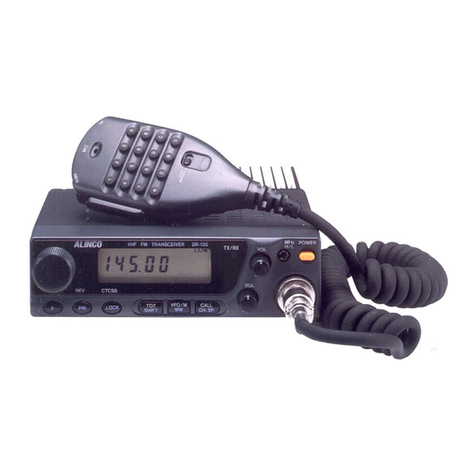
Alinco
Alinco DR-130T Installation manual
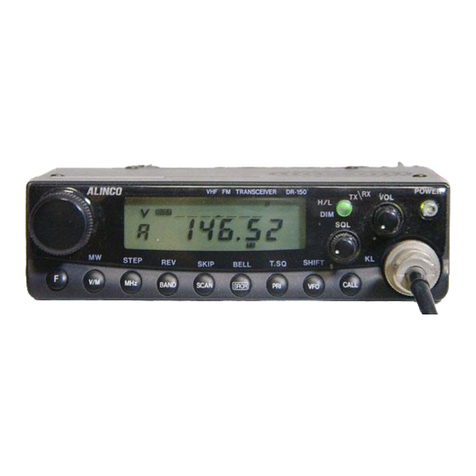
Alinco
Alinco DR-150T User manual
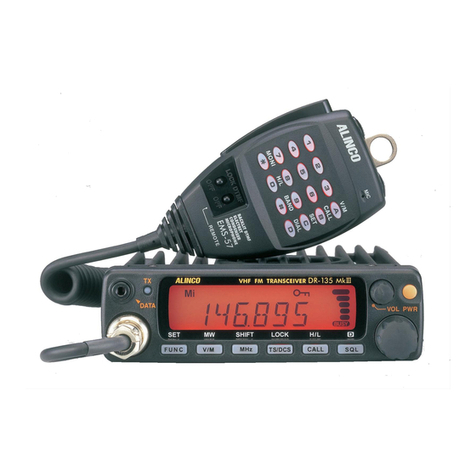
Alinco
Alinco DR-135 User manual
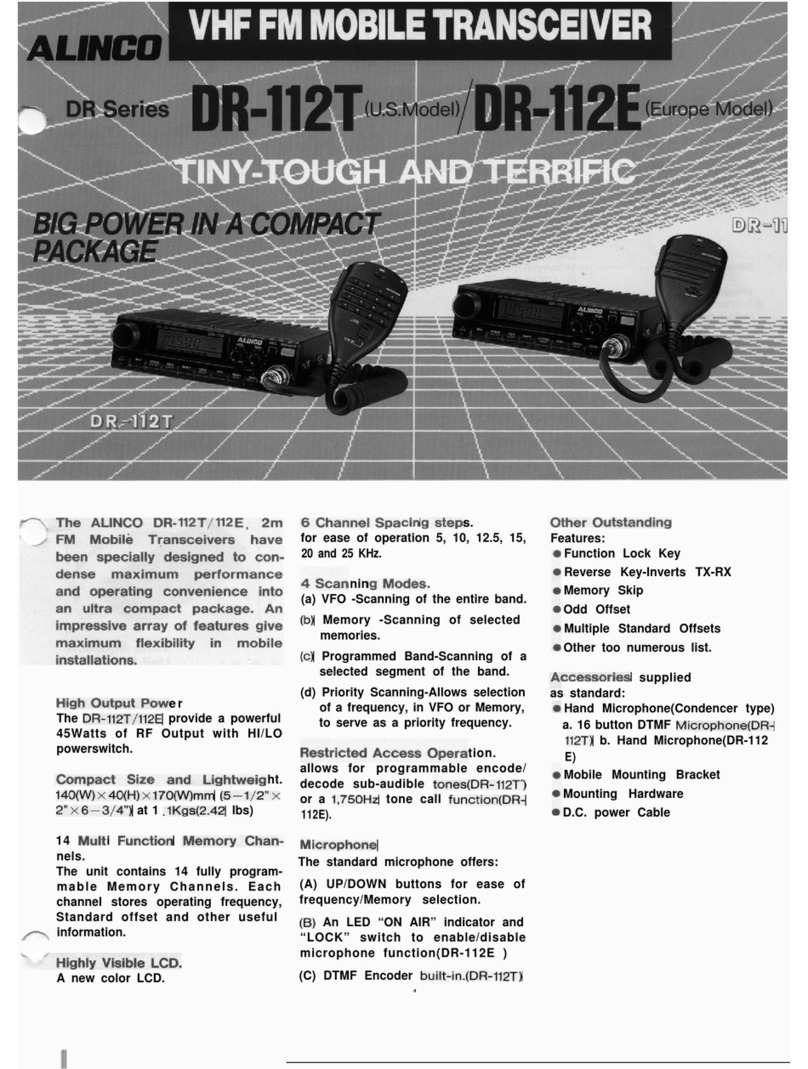
Alinco
Alinco DR-112E User manual
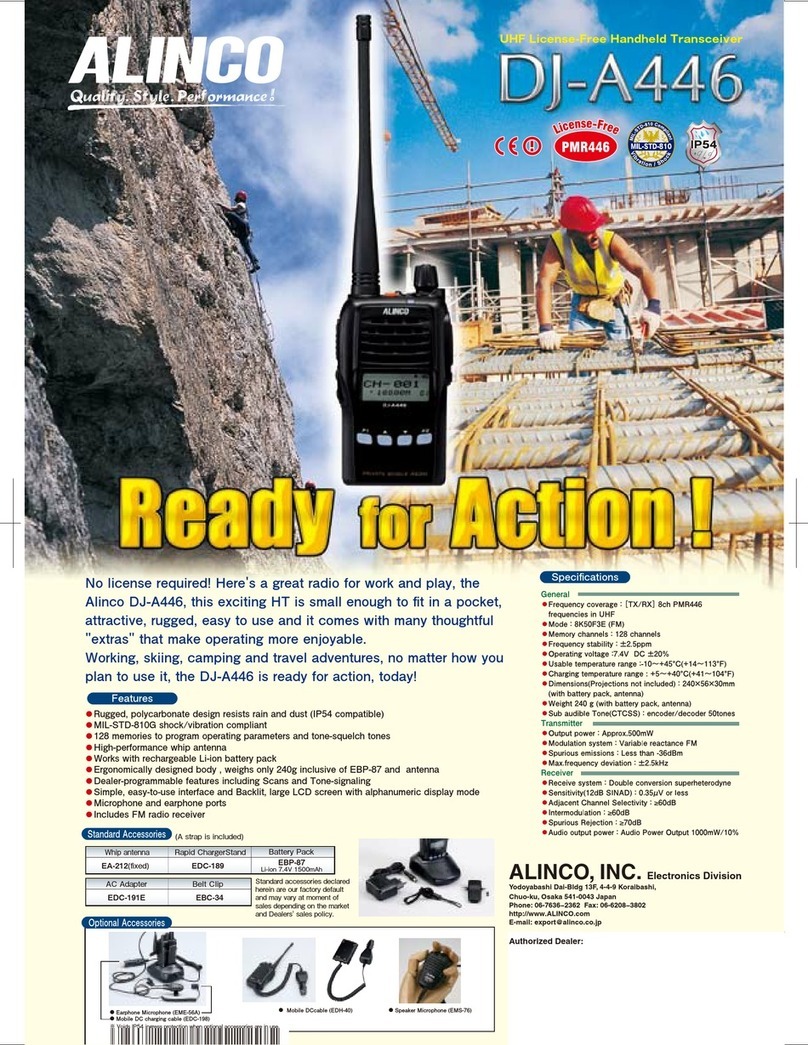
Alinco
Alinco DJ-A446 Owner's manual
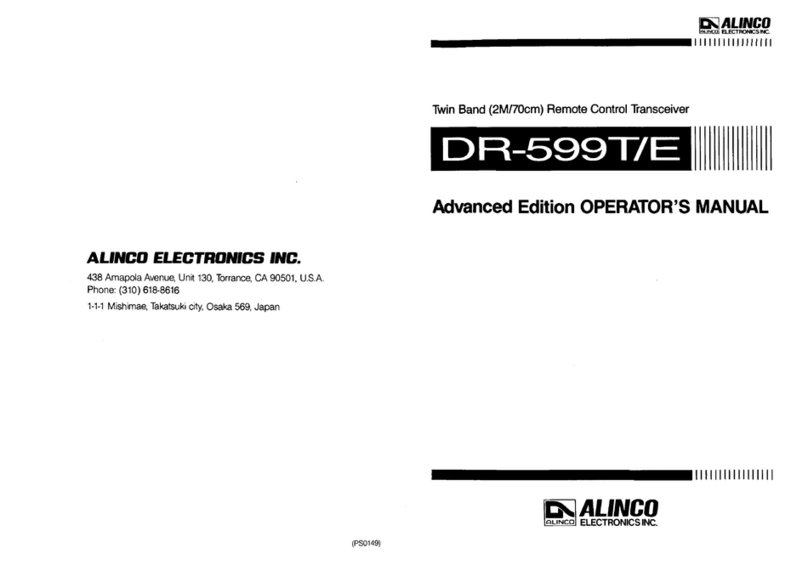
Alinco
Alinco DR-599T User manual
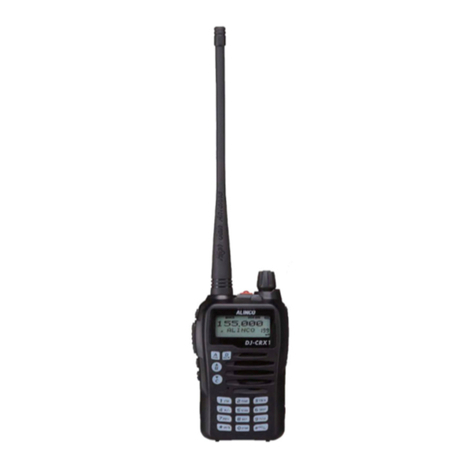
Alinco
Alinco DJ-CRX1 User manual
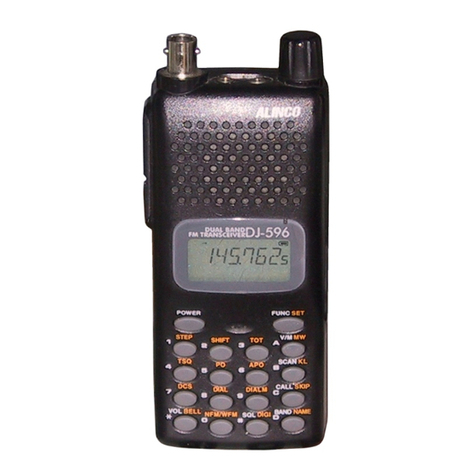
Alinco
Alinco DJ-596T User manual
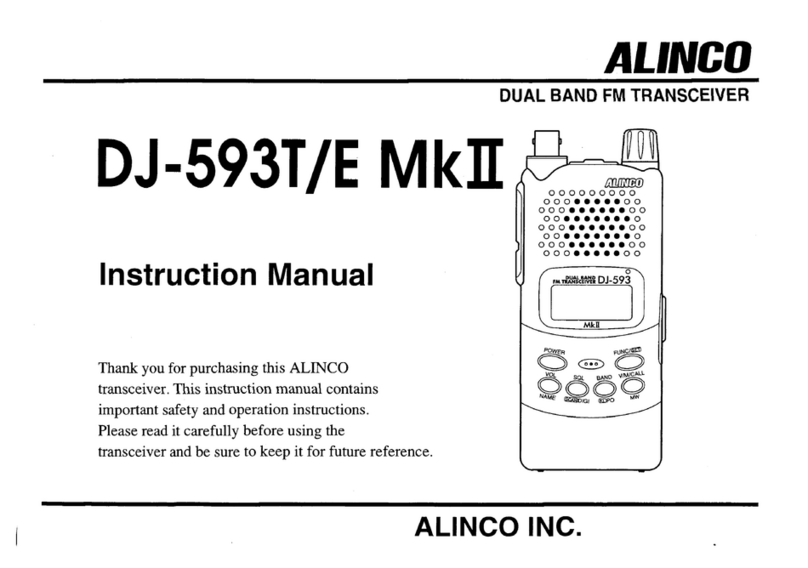
Alinco
Alinco DJ-593E MK II User manual

Alinco
Alinco DR-570T User manual
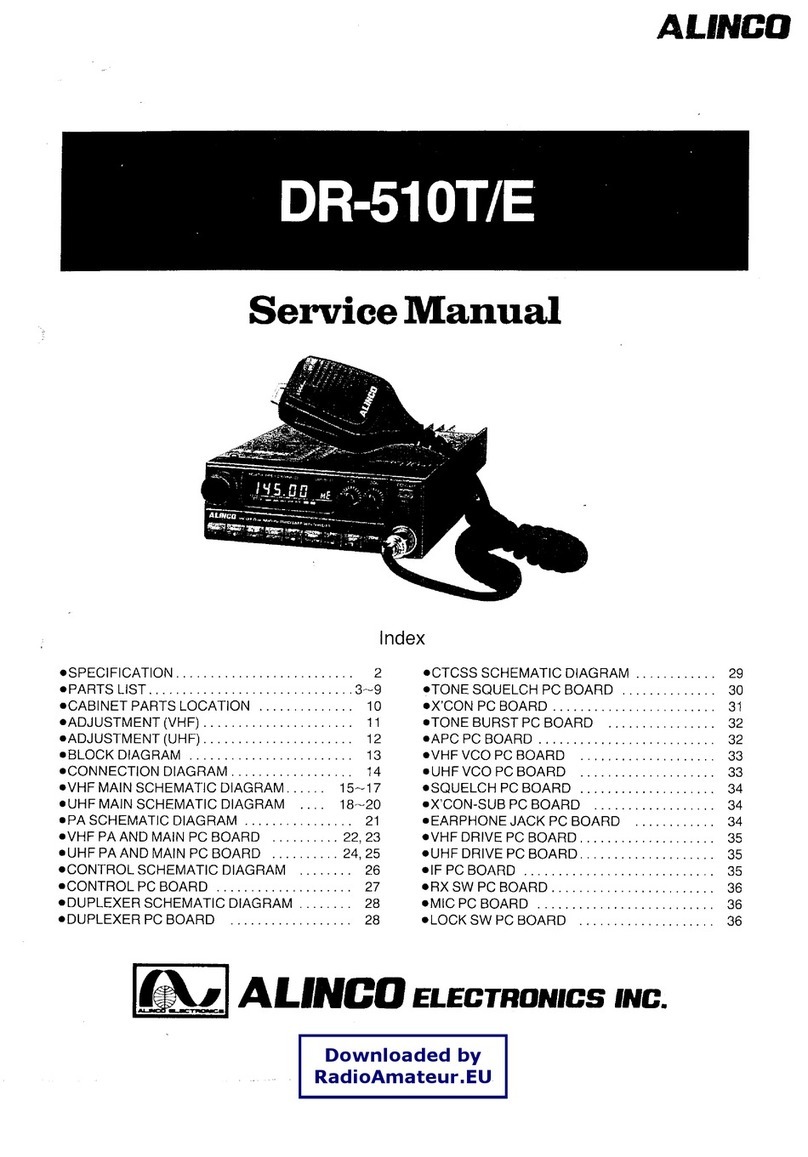
Alinco
Alinco DR-510T User manual
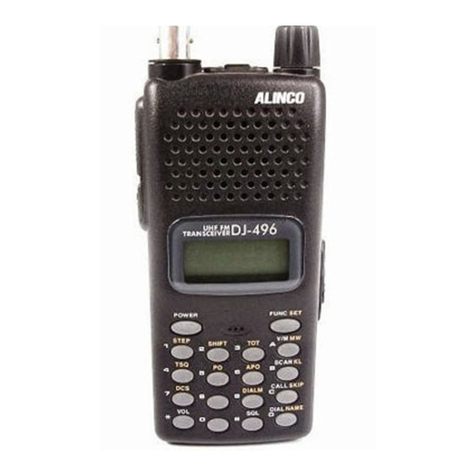
Alinco
Alinco DJ-196 User manual
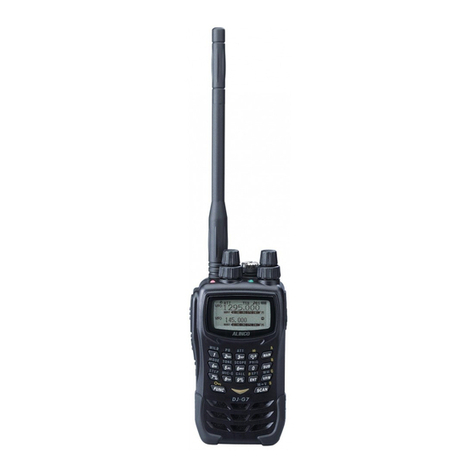
Alinco
Alinco DJ-G7 User manual

Alinco
Alinco DR-135 User manual

Alinco
Alinco DJ-A446 User manual
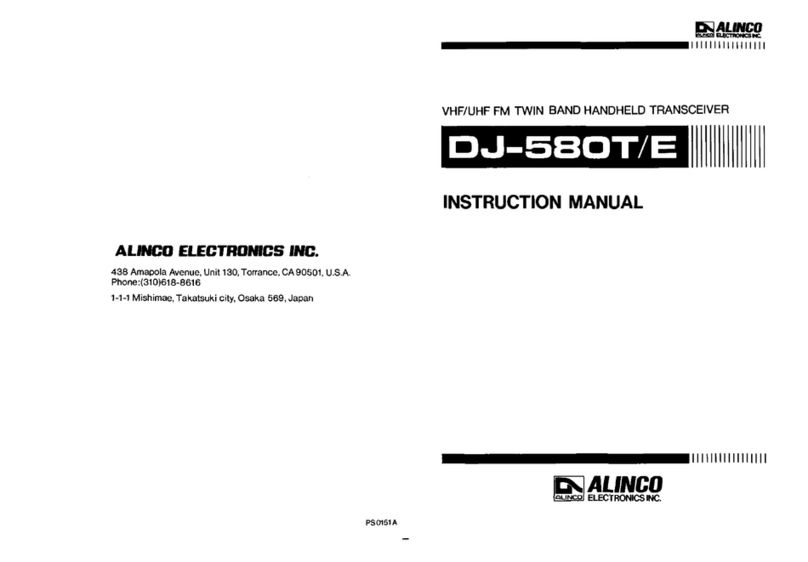
Alinco
Alinco DJ-580T User manual

Alinco
Alinco DR-150T User manual
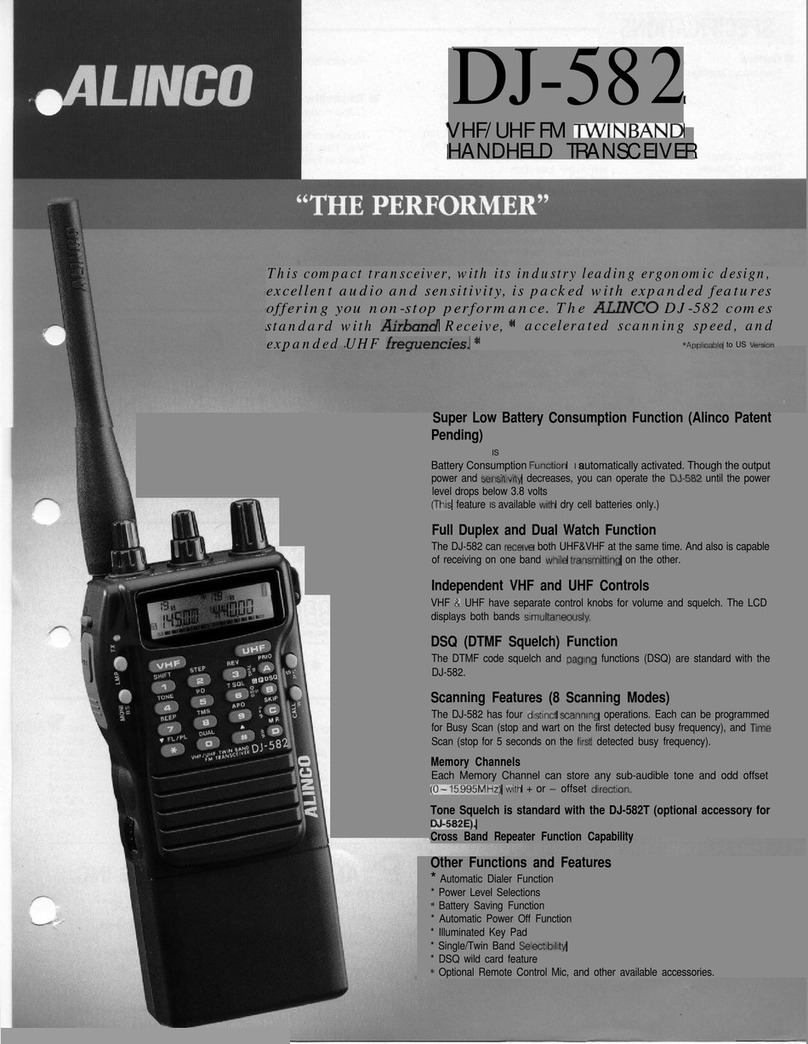
Alinco
Alinco DJ-582 User manual
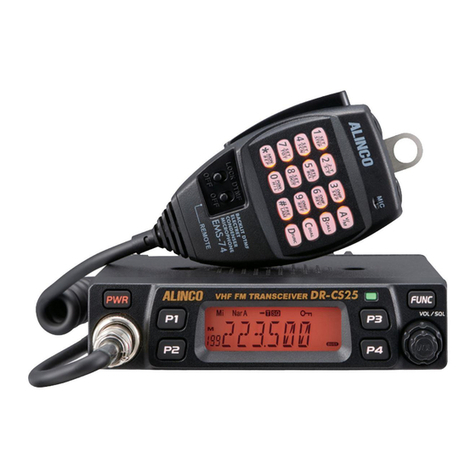
Alinco
Alinco DR-CS25 User manual
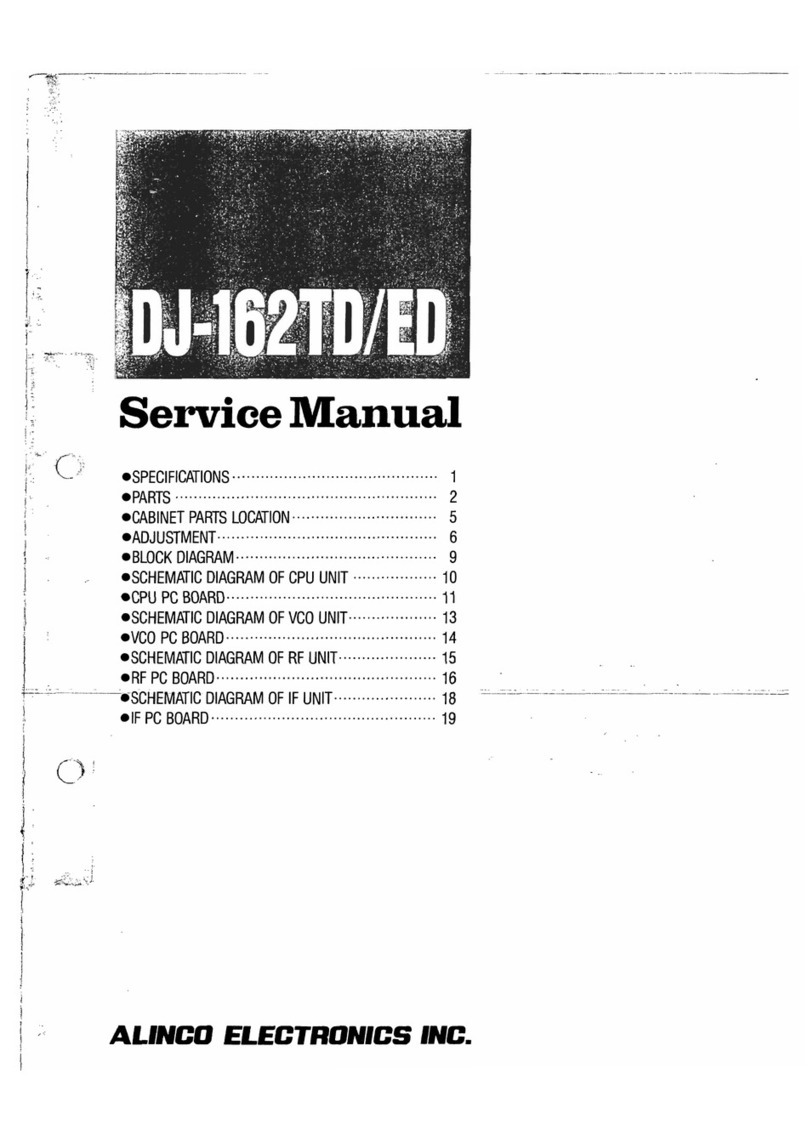
Alinco
Alinco DJ-162TD User manual
